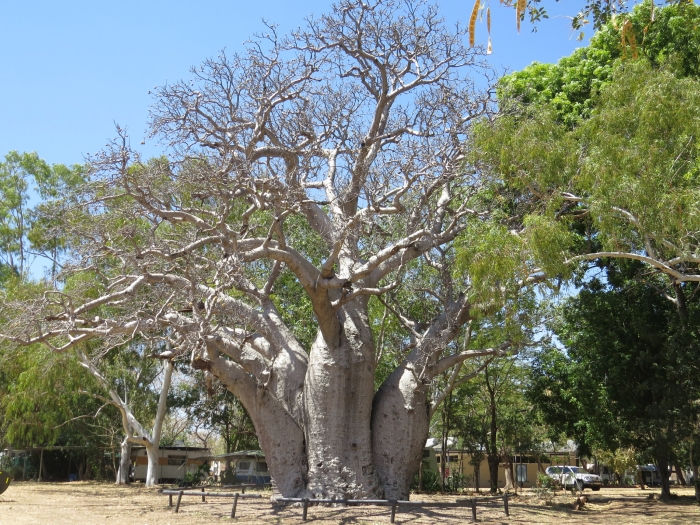Boab
(Adansonia gregorii)
Boab (Adansonia gregorii)
/
/

George Baker
CC BY 4.0
Image By:
George Baker
Recorded By:
Copyright:
CC BY 4.0
Copyright Notice:
Photo by: George Baker | License Type: CC BY 4.0 | License URL: http://creativecommons.org/licenses/by/4.0/ | Rights Holder: George Baker | Publisher: iNaturalist | Date Created: 2013-08-27T13:16:41-07:00 |

























Estimated Native Range
Summary
Adansonia gregorii, commonly known as the boab, is a deciduous tree endemic to the Kimberley region of Western Australia and the western parts of the Northern Territory. It is a distinctive species with a broad, bottle-shaped trunk that can reach up to 16 feet in diameter and a height of up to 49 feet. The boab’s large white flowers bloom from December to May and are followed by large, woody, oval fruits. The bark is smooth and fibrous, capable of storing water and maintaining inscribed markings for over a century. Aboriginal Australians have traditionally used the tree for water storage, food, and medicinal purposes, and the tree holds cultural significance, including its historical use as a prison tree.
The boab is a striking ornamental tree, valued for its unique form and cultural history. It is used in landscaping for its dramatic appearance and shade-providing canopy. In cultivation, it requires a well-drained soil, full sun, and can tolerate dry conditions once established. The boab is slow-growing and can be sensitive to frost. It is not commonly affected by pests or diseases, but root rot can occur in poorly drained soils. Due to its large size and root system, it is best suited for spacious landscapes.CC BY-SA 4.0
The boab is a striking ornamental tree, valued for its unique form and cultural history. It is used in landscaping for its dramatic appearance and shade-providing canopy. In cultivation, it requires a well-drained soil, full sun, and can tolerate dry conditions once established. The boab is slow-growing and can be sensitive to frost. It is not commonly affected by pests or diseases, but root rot can occur in poorly drained soils. Due to its large size and root system, it is best suited for spacious landscapes.CC BY-SA 4.0
Plant Description
- Plant Type: Tree
- Height: 16-50 feet
- Width: 10-25 feet
- Growth Rate: Slow
- Flower Color: White
- Flowering Season: Summer
- Leaf Retention: Deciduous
Growth Requirements
- Sun: Full Sun
- Water: Low
- Drainage: Fast
Common Uses
Bird Garden, Drought Tolerant, Low Maintenance, Showy Flowers
Natural Habitat
Kimberley region of Western Australia and the western parts of the Northern Territory
Other Names
Common Names: Boab, Bottle Tree, Baobab, Baobab Bottletree, Baobab-Tree, Cream-Of-Tartar-Tree, Dead Rat Tree, Gadawon
Scientific Names: , Adansonia gregorii, Adansonia gibbosa, Adansonia gibbosa, Adansonia gregorii f. globosa, Adansonia gregorii f. typica, Adansonia rupestris, Adansonia stanburyana, Baobabus gregorii, Capparis gibbosa,
GBIF Accepted Name: